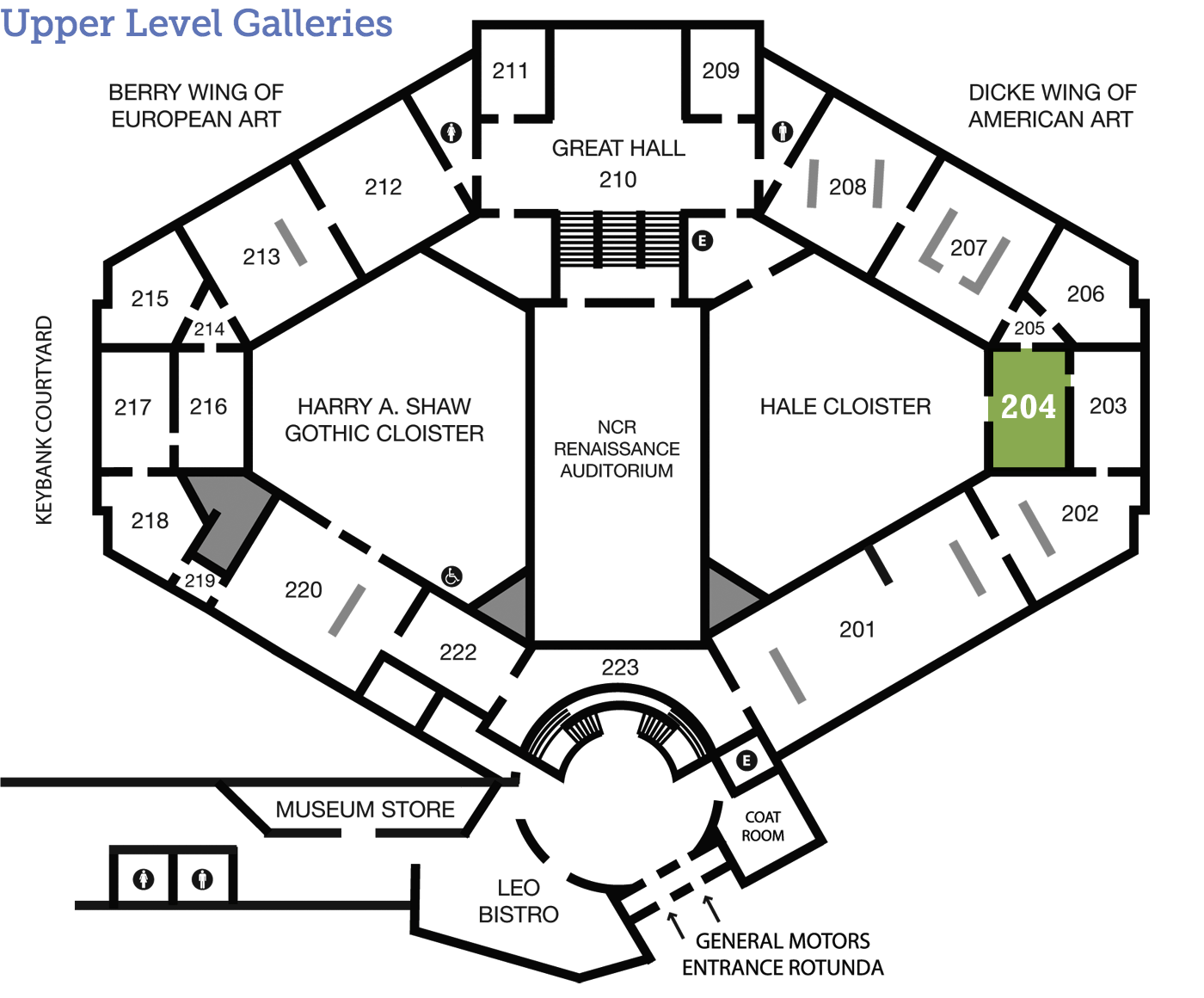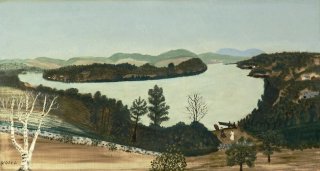
Anna Mary Robertson Moses
Lake Eden, Vermont
(1860–1961)
American 1944 Oil on pressed wood 11 x 21 inches Gift of Stuart and Christine Rose 1994.43 204
Memory is a Painter
When is it too late to try something new? How can you transform the past into a promise for the future? Taking up painting late in life, Anna Mary Robertson Moses combined a rich store of memories about country life with a vibrant vision that still inspires us to find hope in human life.
A Day in the Life
Tools and Techniques
From Stitch to Stroke
Before she started painting, Anna Mary Robertson Moses enjoyed making pictures of crewel embroidery, a kind of free-form embroidery that stitches worsted wool into images sketched on fabric mounted on a supportive frame. A craft with a long history, here is one early example from Jacobean England in The DAI’s collection.

Unknown Maker (England, Great Britain, late 17th century), Crewel Work Tapestry, c.1675, wool embroidery on linen or cotton. Gift of Mrs. Harrie G. Carnell, The Dayton Art Institute, 1944.97.
Moses switched to painting because of her arthritis, but you can still see traces of embroidery in her painting technique, which often places colors next to each other instead of blending them. The influence of embroidery is also seen in the size of Moses’ paintings: just as she did needlework on her lap, so she primarily painted on her lap, working with boards that were small and easy to handle.
An artist based in Dayton who also used needlework to create engaging pictures is Mary Borkowski. Examples of her work in The Dayton Art Institute’s collection include Distortion.
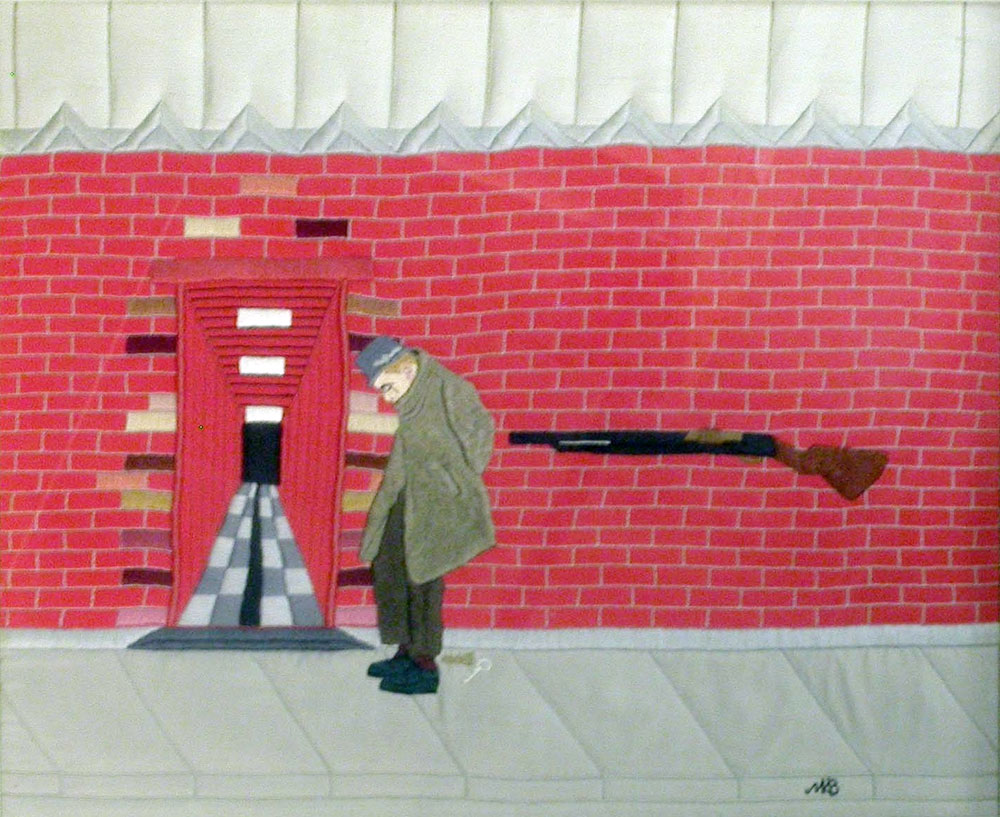
Mary K. Borkowski (American, 1916–2008), Distortion, before 1968, cotton, embroidery, 16 1/8 x 18 1/8 inches. Museum purchase, 1968.57.
Behind the Scenes
Look Closer
Just for Kids
Look!
Anna Mary Robertson Moses, known as Grandma Moses, taught herself how to paint. She started painting when she was around 80 years old. Grandma Moses often painted rural landscapes, like this one. What makes this landscape rural? Why is it not considered urban?
Look carefully at Grandma Moses’s painting. What season do you think it is? How can you tell? What would it look like in winter? What might this scene look like during spring time?
Signs & Symbols
Dig Deeper
Arts Intersected
Grandma Moses Comes to Dayton
Grandma Moses visited the Victoria Theater Association in Dayton twice in the form of the play Grandma Moses: An American Primitive. Starring Cloris Leachman and written by Stephen Pouliout, the two-act play presented Moses during two phases of life, as a middle-age farmer and an elder art icon. The first run was June 12–17, 1990, and the second—presented as part of the theater’s Broadway Series—was from April 5–17, 1994. Below is a photo of the promotional poster.
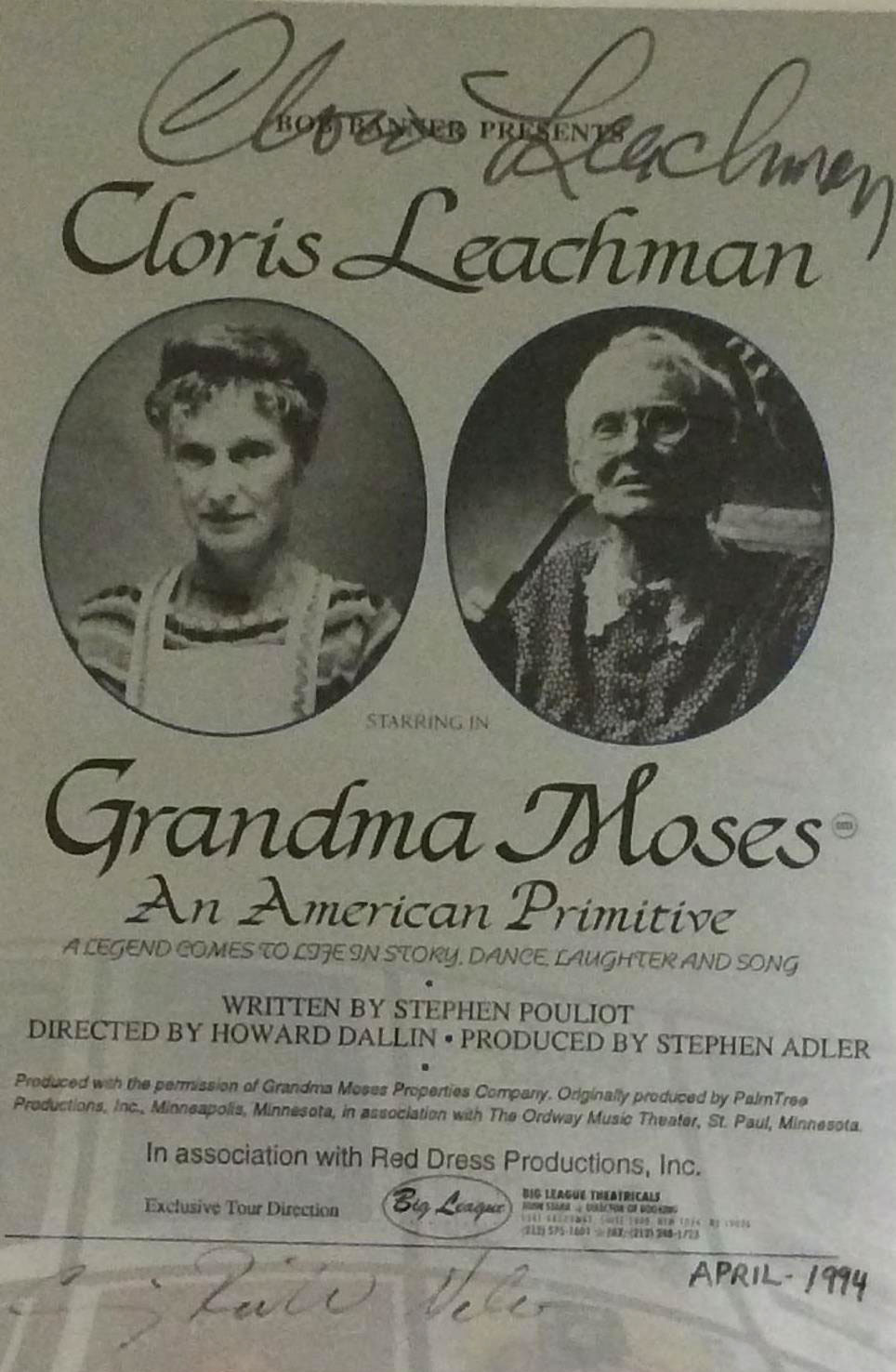
Poster for Grandma Moses: An American Primitive (photograph provided by the Victoria Theater Association, Dayton, Ohio).
In Fall 2015 a version of this play premiered at The DAI in conjunction with the exhibition American Sampler: Grandma Moses and the Handicraft Tradition. You can read more about the exhibition here.
The Sculpture Speaks
Did You Know?
Expert Opinion
Look Around
Who are You Calling Naïve?
Grandma Moses was famously an untrained artist. Look at some of the other landscape paintings in the nearby galleries by professionally trained artists, such as Childe Hassam’s Early Morning Calm, or Albert Bierstadt’s Scene in Yosemite Valley. How does Grandma Moses’ use of colors, brushstrokes, and light compare with these?
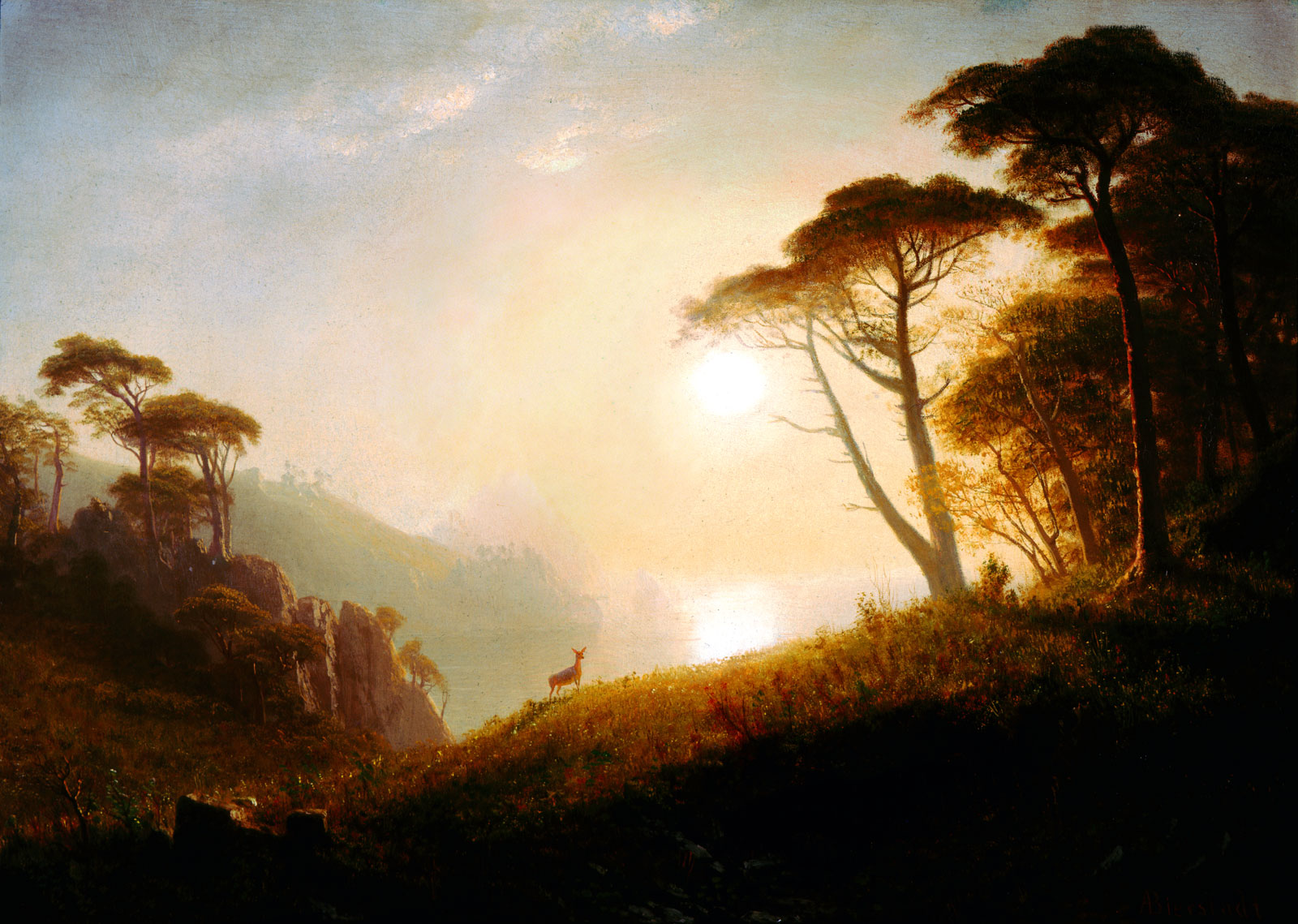
Albert Bierstadt (American, 1830–1902), Scene in Yosemite Valley, 1864–1874, oil on canvas, 20 7/8 x 29 inches. Museum purchase with funds provided by the Daniel Blau Endowment Fund, 1976.58.
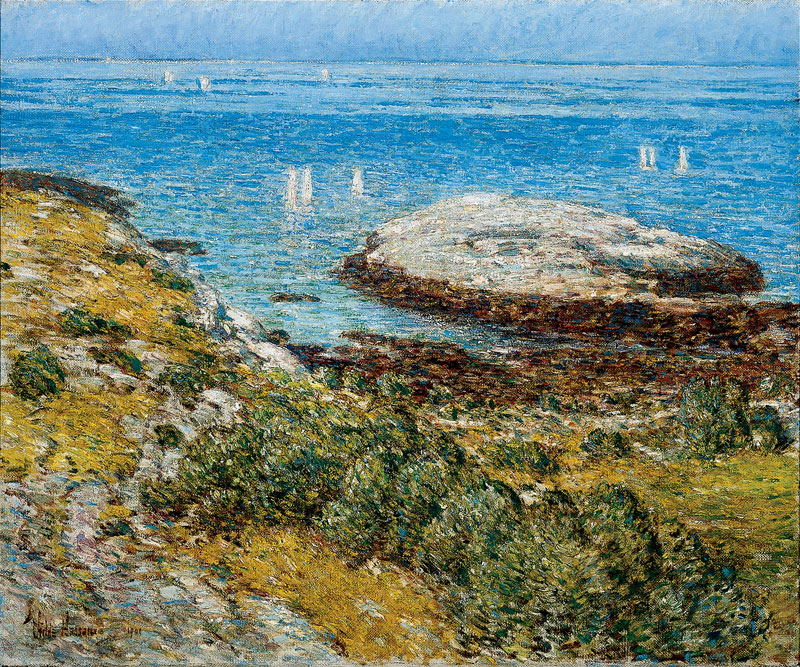
Childe Hassam (American, 1859–1935), Early Morning Calm, 1901, oil on canvas, 25 x 30 inches. Gift of Mrs. Harrie G. Carnell, 1942.3.
Different words have been used to describe Grandma Moses’ art, including calling it “Naïve Art.” Here is one definition of Naïve Art: “Term applied to painting…produced in more or less sophisticated societies but lacking conventional expertise in representational skills. Colors are characteristically bright and non-naturalistic, perspective non-scientific, and the vision childlike or literal-minded.” Does this accurately describe Grandma Moses’ art? Can you think of another word, perhaps in consideration of the relationship of her paintings to her handiwork?
Quote from Ian Chilvers, Oxford Concise Dictionary of Art & Artists, 3rd ed. (Oxford: Oxford University Press, 2003), p. 410.
About the Artist
A Late Bloomer
Known as “Grandma Moses,” Anna Mary Robertson Moses took up painting in earnest in her late 70s, after a life of farming and raising a family. When arthritis made it difficult for her to continue stitching the embroidered pictures she enjoyed giving to friends and family, Moses took to the brush. Her work was brought to the attention of the New York art world by the collector Louis Caldor, and then successfully promoted by Otto Kallir at his Galerie St. Etienne, which remains the artist’s primary representation today. You can see what Moses looked like from a label on the back of The DAI’s painting, on which she signed the date, number and title of Dayton’s painting.
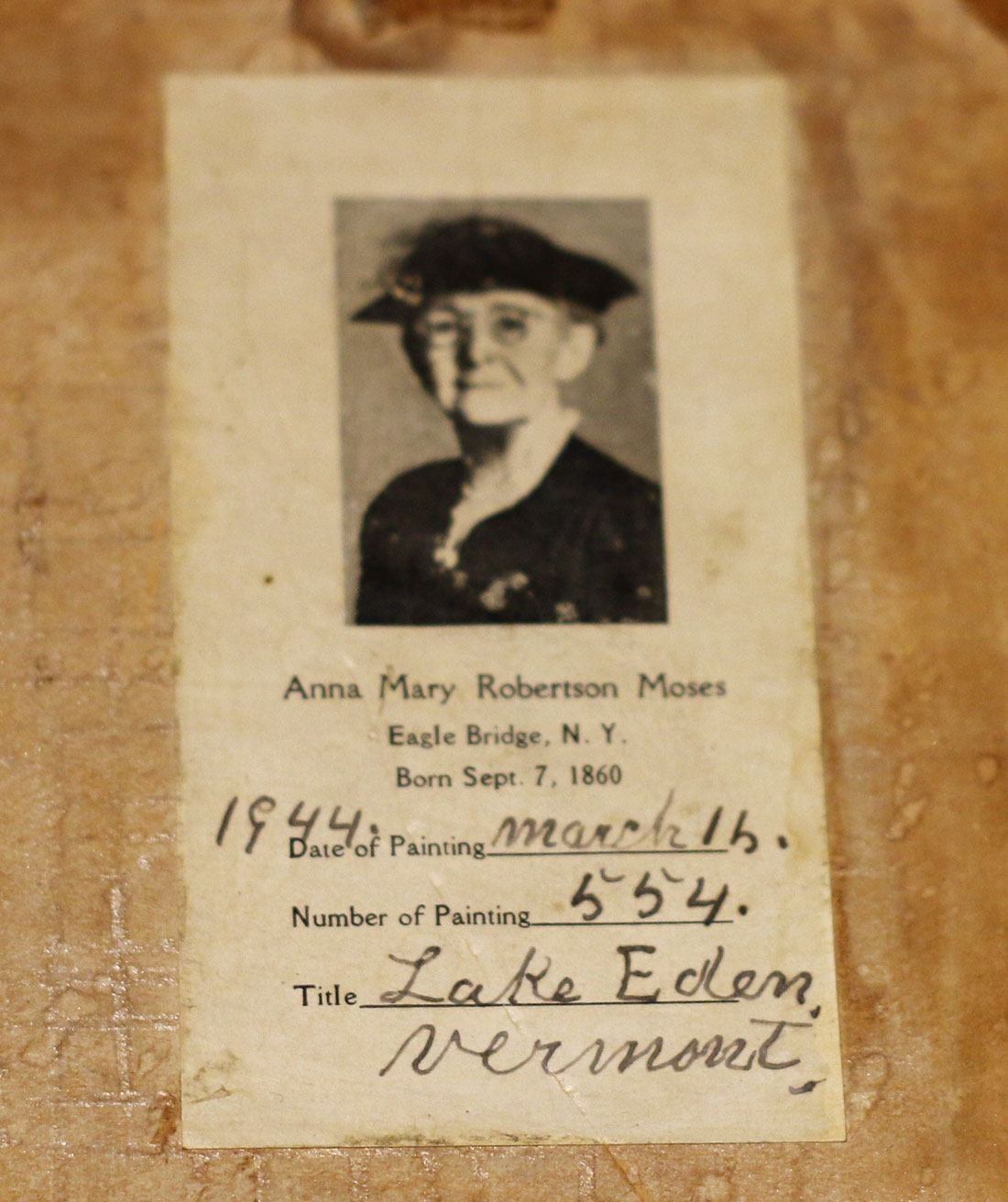
Detail, back of painting
Grandma Moses’ unique story, her down-to-earth personality, and her vivid portrayal of country life appealed to a wide audience. With the increase in mass communications and marketing during the 1940s and 1950s, she became a somewhat surprising celebrity. A documentary about her by Archibald Macleish was nominated for an Academy Award in 1950 and her autobiography was published in 1952 (My Life’s History). There was even a docu-drama about her life in the TV series “Schlitz Playhouse of Stars” in 1952. Guess which famous early film actress portrayed her:
Mary Pickford, c.1915, photograph. Library of Congress Prints and Photographs Division, Washington, D.C. (photograph in the public domain; photograph provided by the Prints & Photographs Division, Library of Congress, LC-USZ61-1814).
Arnold Genthe (American, 1869–1942), Portrait Photograph of Greta Garbo, between 1925 and 1942, from a negative taken 1925, slide. Library of Congress Prints and Photographs Division, Washington, D.C. (photograph in the public domain; photograph provided by the Prints & Photographs Division, Library of Congress, LC-G4085- 0374).
Charles Albin (American, 1882-19??), Lillian Gish, 1922, photograph. Library of Congress Prints and Photographs, Division, Washington, D.C. (photograph in the public domain; photograph provided by the Prints & Photographs Division, Library of Congress, LC-USZ62-136510).
Talk Back
Fame, What is It Good For?
Grandma Moses was noticed by the art world for being an interesting self-taught folk artist, but her place in this community has been somewhat ambivalent. At the same time, her work became very popular; being reproduced on greeting cards, plates, and other merchandise, but this could make it seem mass-produced. Grandma Moses pursued neither acceptance by the art world or the mass market. What role does critical and/or commercial success play in determining the quality of a work of art?

